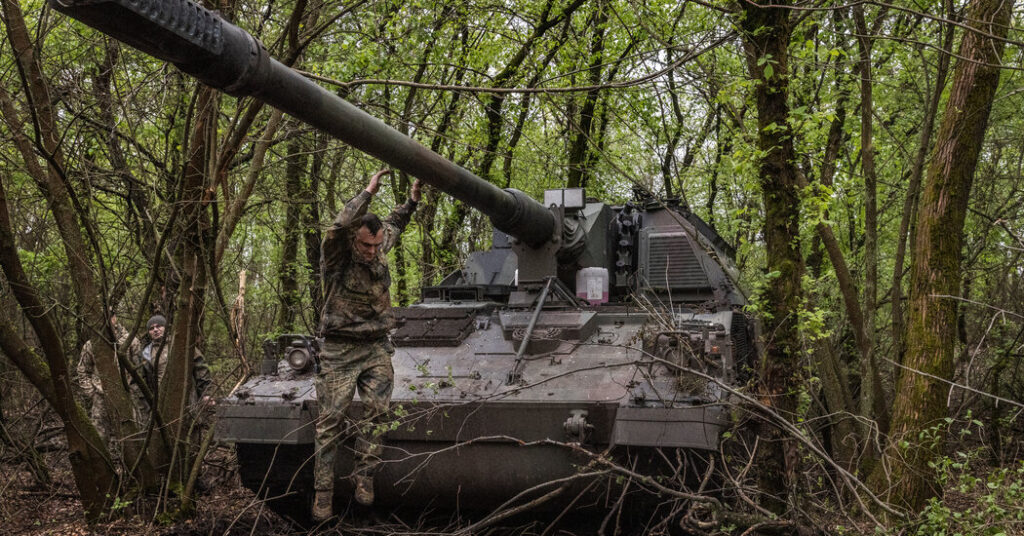The troops of Ukraine’s 43rd Separate Artillery Brigade have just about everything they need to begin the expected spring counteroffensive. They are well rested, have plenty of ammunition and are now in possession of several advanced German-made self-propelled howitzers, which have replaced their old Soviet artillery pieces.
But for the moment, they are barely moving forward, stalled not by ferocious Russian attacks, but by an enemy no less tenacious: the viscous central Ukrainian mud.
“Until the weather improves, there will be no counteroffensive,” said a lieutenant with the brigade named Serhii. “The vehicles will get stuck and then what will we do if the shooting starts?”
Deep and black, with a consistency similar to a mixture of cookie dough and wet cement, the spring mud is one obstacle that the Ukrainian military, for all its ingenuity, finds difficult to overcome. It jams weapons and steals the boots from soldiers’ feet. Wheels and treads spin and spin, only digging military vehicles deeper into the mire.
Serhii made the decision to pull all of the new Panzerhaubitze 2000s from the field, for fear that the 60-ton howitzers would be unable to escape should they come under fire. Last week, one had to be towed when it became stuck in the mud. Over the weekend, at the unit’s rear position in southeastern Ukraine’s Zaporizhzhia region, troops were busy scraping off a heavily caked layer of sludge from treads and armored plating.
Ukraine is under pressure to launch a counteroffensive and avoid a stalemate that could last through 2023 or longer. Failure to make some progress in the war, by recouping stolen land or inflicting serious damage on Russian forces, could harm morale and test the patience of Ukraine’s western backers.
The Zaporizhzhia region, half-occupied by Russian forces, and with vast farm fields leading down to the Azov Sea, is considered a likely area for Ukraine’s big push. But among all the variables commanders must consider before launching the attack, the weather may be the most unpredictable.
Ukraine is counting on the heat of late spring and summer to dry the ground into firm pavement — ideal for the heavy tanks and artillery pieces that will be central to the counteroffensive. But when that will happen is anyone’s guess. The spring rains have been much more intense this year than normal. The heavy downpours in Zaporizhzhia over the last few weeks have turned the battlefield into a gelatinous soup.
“This has been an unusual spring,” a commander with the brigade said. “There has never been this much rain before.” He identified himself by his call sign, Kubik; like other Ukrainian commanders, he spoke on the condition that his full name not be used, for security reasons.
The 43rd Brigade received delivery of the heavy Panzers from Germany and the Netherlands over the winter. After several weeks of training in Germany, the brigade has spent the last few months getting acclimated to the advanced artillery system on the battlefields in this region.
The German howitzer is superior in many ways to the Soviet-made Peony artillery system it replaced. It is full of bells and whistles like an electronic targeting system and automatic loading, allowing soldiers to rapidly fire a volley of shells in less than half the time it would have taken to fire one shell on the old system.
It is also safer. Soldiers ride within an armored capsule, which the men said had withstood direct hits by mortars and indirect fire from an array of artillery shells. The Peony, which Russia’s forces also possess, had no armor, and soldiers would ride on top, exposed to whatever the Russian side could throw at them.
Russia has modernized versions of Soviet-made self-propelled howitzers, though Ukrainian troops said they more often faced off against older Soviet weapons systems, particularly multiple-rocket launchers like Grads or Hurricanes.
Russian artillery also occasionally get stuck, but because of its metal, claw-like tracks, the Peony actually performs better in muddy conditions. The Panzers delivered to the Ukrainian unit have rubber treads that are better for flat, hard surfaces, troops said.
In the right conditions, the Panzer is fast and maneuverable, allowing soldiers to fire off a few rounds and then scoot away before the Russian side returns fire. A howitzer commander who uses the call sign Boychik said it was “like the difference between a Zhiguli and a Mercedes,” referring to a cheap, Soviet-era car.
But the howitzer is also delicate. Its sensitive electronics go haywire when exposed to moisture or dirt. The soldiers have to put on special booties or slippers when they go inside to avoid tracking in mud, and each vehicle comes with its own vacuum cleaner. In Germany, soldiers said, the howitzers had their own climate-controlled garages where they were stored when not in use — conditions clearly not available on the Ukrainian battlefield.
“The Panzer really loves cleanliness,” said Mykola, a young artillery commander. He and his men were struggling to clean out the barrel of their mud-encrusted howitzer with a long metal brush like a chimney sweep. “If you fire off two full loads of ammunition, you need to spend a day servicing it,” he added.
On the battlefield, the Panzers have performed well so far, the muddy conditions notwithstanding. The day before they were called to their rear base because of the weather, Mykola said his team had scored two direct hits on a Russian tank and taken out some infantry.
Russian forces typically blanket an area with artillery fire, he said, hoping to hit something in a massive barrage. His team often achieves better results with fewer shells, he said.
“Of course, we’re all waiting for the counteroffensive,” Mykola said. “Only forward.”
Looking around at the thick mud, Yuri, one of his teammates, gently chided him: “But where are you planning to go?”

